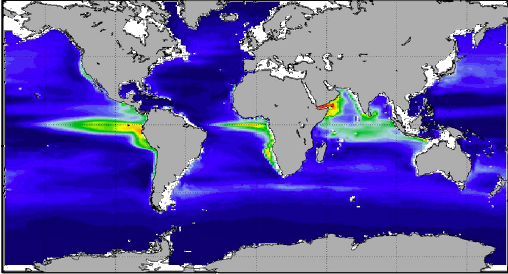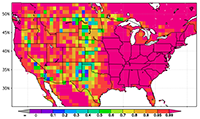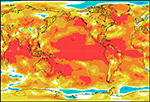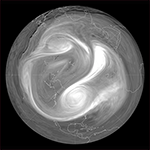GMAO RESEARCH HIGHLIGHTS, 2013-2015
Below are titles and descriptions of GMAO Research Highlights entries from 2013 through 2015. These writeups are summaries of selected GMAO scientific research activities.
2015
 Skin Sea-Surface Temperature Assimilation in GEOS-5 Atmospheric Data Assimilation System[12.09.2015 ]
Skin Sea-Surface Temperature Assimilation in GEOS-5 Atmospheric Data Assimilation System[12.09.2015 ]
Satellite and in-situ observations of the Sea-Surface Temperature (SST) show high variability, including a diurnal cycle and very thin, cool skin layer in contact with the atmosphere. The GEOS-5 Atmospheric Data Assimilation (ADAS) has been modified to incorporate these effects and also to assimilate Advanced Very High Resolution Radiometer (AVHRR) brightness temperatures to obtain realistic estimates of the skin SST. Results with the updated system for one-month experiment indicate an overall improvement in the performance of the ADAS.
» Read More.
» Read More.
2014
 Quantifying the observability of CO2 flux uncertainty in atmospheric CO2 records using products from NASA's Carbon Monitoring Flux Pilot Project [10.30.2014 ]
Quantifying the observability of CO2 flux uncertainty in atmospheric CO2 records using products from NASA's Carbon Monitoring Flux Pilot Project [10.30.2014 ]
» Read More.
Carbon dioxide (CO2) is an important greenhouse gas, yet much uncertainty surrounds the processes controlling its flux from land and ocean to atmosphere. NASA’s GEOS-5 model was used to transport different flux estimates through the atmosphere to assess when uncertainties related to flux estimates were large enough to distinguish from weather-induced natural variations.
» Read More.
» Read More.
 Sensitivity of Tropical Cyclones to Parameterized Convection in the GEOS-5 Model [9.19.2014 ]
Sensitivity of Tropical Cyclones to Parameterized Convection in the GEOS-5 Model [9.19.2014 ]
This study demonstrates that realistic Tropical Cyclone activity can be simulated in GCMs with a resolution of about 25km and that modifications to the convective parametrization can lead to further improvements in the realism of the TCs.
» Read More.
» Read More.
 Interannual Variation in Phytoplankton Primary Production at a Global Scale [9.11.2014 ]
Interannual Variation in Phytoplankton Primary Production at a Global Scale [9.11.2014 ]
The contributions of four phytoplankton groups to the total primary production are computed using the GMAO’s "NASA Ocean Biology Model." The work isolates the effects of climate variability on group-specific primary production using global and regional climate indices.
» Read More.
» Read More.
 High-resolution GEOS-5 simulations of stratospheric ozone intrusions [ 2.14.2014 ]
High-resolution GEOS-5 simulations of stratospheric ozone intrusions [ 2.14.2014 ]
A 25-km resolution version of GEOS-5 has been used with a comprehensive stratosphere-troposphere chemistry module to test the feasibility of detecting the impacts of stratospheric ozone intrusions on surface air quality.
» Read More.
» Read More.
2013
 Verifying GEOS-5 sulfur dioxide simulations [9.19.2013 ]
Verifying GEOS-5 sulfur dioxide simulations [9.19.2013 ]
The Frostburg field campaign in November 2010 provided the opportunity to evaluate the simulation of SO2 and sulfate aerosols in GEOS-5.
» Read More.
» Read More.
 Sea Surface Temperatures, Heat, and Drought in the U.S. [8.12.2013 ]
Sea Surface Temperatures, Heat, and Drought in the U.S. [8.12.2013 ]
The GMAO has conducted a series of experiments to determine what role, if any, SST anomalies played in forcing the extreme drought and heat waves experienced over the U.S. during the summers of 2011 and 2012.
» Read More.
» Read More.
 Quantifying Improvements to Streamflow Forecasts Stemming from Improved Soil Moisture Observations [ 7.2.2013 ]
Quantifying Improvements to Streamflow Forecasts Stemming from Improved Soil Moisture Observations [ 7.2.2013 ]
The GMAO has conducted simulations to quantify the positive impacts that the soil moisture information provided by SMAP will have on streamflow forecasts.
» Read More.
» Read More.
 GEOS-5 contributions to the National Multi-Model Ensemble [ 3.25.2013 ]
GEOS-5 contributions to the National Multi-Model Ensemble [ 3.25.2013 ]
The GMAO is an integral part of the National Multi-Model Ensemble project, an effort to improve intra-seasonal-to-interannual climate forecasting.
» Read more..
» Read more..
 Simulating the Transport of Aerosols with GEOS-5 [ 2.27.2013 ]
Simulating the Transport of Aerosols with GEOS-5 [ 2.27.2013 ]
The GMAO has conducted high resolution GEOS-5 simulations of tropospheric aerosols transported around the globe.
» Read more and view simulation results.
» Read more and view simulation results.
 GEOS-5 Successfully Predicts Stratospheric Sudden Warming Event [ 1.30.2013 ]
GEOS-5 Successfully Predicts Stratospheric Sudden Warming Event [ 1.30.2013 ]
The GMAO's near-real-time meteorological analyses and weather forecasts with GEOS-5 successfully predicted the major stratospheric sudden warming event of January 2013.
» Read a discussion and initial analysis of this event.
» Read a discussion and initial analysis of this event.

